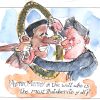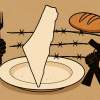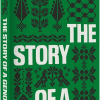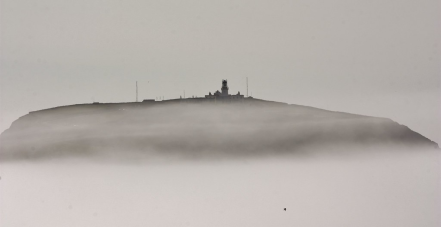
By Nick Moss
We started a poetry and open mic night at the Cockpit Theatre in Marylebone, London NW8 after we organized a “farewell festival” for Smokestack Books there. The theatre gave the evening the name “Re-Enchant”, which I’ve never been over-enamoured with (it sounds like a mash-up between wicca and a postmodernist critique of the Frankfurt School – or do they amount to one and the same thing?) but the event has been a kind-of success, in that it’s given a platform to the voices around Smokestack and Culture Matters who’ve been able to attend.
I’m not usually a big fan of the theatre either, but the Cockpit deserves a plug for being willing to experiment, give space to new work, and be avowedly political. They do a not-for-profit scratch night, designed for individuals or groups of performers to try out or showcase 10-15 minutes of new work, which function as an accessible, affordable way for artists to try out new work on stage with full support from their backstage and tech crew. Tickets are £1 so it’s a cheap and fun night out, with the chance to see new work.
Anyway, one of the joys of “Re-enchant” has been hearing genuinely exciting new (to me) voices via the open mic spots. I want to briefly profile two of these poets here, because they strike me as being writers who are already taking risks in their work, and have ways of approaching the world that are original and powerful.
Oh Be Quiet
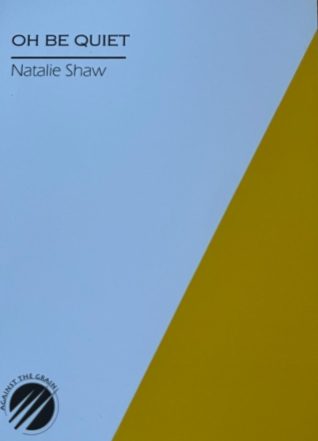
Natalie Shaw attempts in her poetry to provide a primarily disenchanted view of the world. She renders the domestic sinister and shadowed. Sigmund Freud, in his often-cited 1919 essay The Uncanny, writes of the etymology of the words ‘heimlich’ and ‘unheimlich’ (or ‘homely’ and ‘unhomely’, as they translate into English) and Natalie’s poetry feels like a working-through of the implications of this , as she scratches away at the homely to uncover the dread concealed beneath.
Her new poems feature a character called the Gangmaster, and the poems draw on the kind of sinister nursery-rhyme imagery that haunts the paintings of Paula Rego, or (to pick up the reference to Freud ‘s essay again) E.T. A. Hoffman’s Sandman story. The Sandman is a nightmare character who steals the eyes of children and the Gangmaster is similarly perturbing. One of the particular joys of all this is hearing it read in the cool, deadpan tone Shaw uses, which draws out the chill and the sly humour of the poems. There is real pain in her poems also, as in Anaemia:
My sharp little knife
Black blooms oxidised on the blade
Iron tang singing on my tongue
Slitting through skin to spilled insides.
She is equally, though, capable of extraordinary tenderness, as in her stunning poem of childhood and the shared experiences of mother and son, “How to tell your son he has no friends” – “Tell him it’s your gap too,tell him / tell him. Hear him breathe.”
Her chapbook Oh Be Quiet was published by Against the Grain and copies may still be available from them.
Enchant / Extinguish
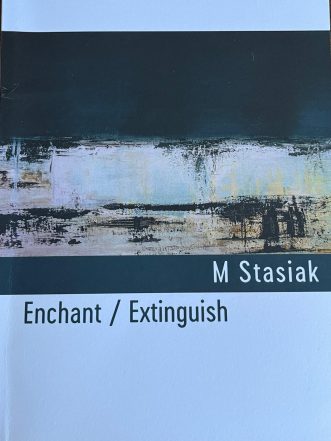
M Stasiak is a Newfoundland-born poet who now lives and works in London. Her work stands out first of all for her exceptional ability to capture the essence of place and of how place resonates with, and is under attack by, sound. Her sensitivity to sound is remarkable, and portrayed with language that itself moves between the hammer and the feather:
How can they tell us to
keep the music down
when crushing up around us
are the mineral sounds of industry
metal beating metal
in our ears, train tracks driving
fractures through our bones.
(from Vertigo)
These are trees of transience and loss
they listen wind-chime fragile in the moving air
(from Trembling Aspen)
The spaces she inhabits are gothic, and stand halfway between light and dark, rural and urban, potential and defeat. “Into the rooms, the dim squatted rooms / adrift in the city and my skin”. (from All of this is enough.) In The Breakers, Stasiak states:
In the underwater swell
I have abandoned myself, become the breakers
as well as the broken-upon, had faith
that sometime, if not now and if not
near to home, I will be washed ashore.
Any such faith is hard-won, though. There is a glimpse of domestic violence in the poems, and of violence in the streets outside. Moreover, M Stasiak gives us a bracing materialism that recognizes us as forces of environmental destruction, and also as just objects falling to decay in a wider landscape. “This where / the core of basalt hauls in continents, draws / them to a centre / heaving with currents / and dark resistant time.” (from The iron catastrophe). “We realised in the end/ the most effective strategy/the best technique/was probably distraction/and we were pleased with ourselves/because distraction is an infinite/ enjoyable resource/ and we are good at it/Damned good.” (from Disordered). There is in all this, something cruel and unflinching, a staring-at what remains possible of the political, of the subject, when “There’s no autonomy/ I don’t know why/we thought there was.” The question is unanswered. Stasiak is “archivist/.I came to trace your story/ bring back pieces…” (from Archivist.) As precursors, Jorie Graham and Thomas A Clark come to mind, but also the philosopher Jane Bennett’s “vital materialism.”
M Stasiak has a new book out with Shearsman Books in 2026. Her chapbook Enchant / Extinguish is still available from them.
Flyweight

Maggie Sawkins’ Flyweight has been released as a book and e-book by Culture Matters. It is a book that manages to make play with pain as a way of coming through and surviving. It deals with family breakdown and the trauma of illness with wit and a willingness to have fun with form. Some of this kind of stuff would normally have me throwing the book on the floor in exasperation. The influence of Paul Muldoon is, I think lurking somewhere in here, and I think Muldoon and his acolytes should be placed in a room and made to listen to nothing but recordings of their tiresome juvenile punnings until they beg for mercy. (You can even imagine Muldoon then writing about his “punnishment beating” just to try and respond to the torment.)
There is a smug complacency about contemporary poetry of which Muldoon is the laureate and it annoys the hell out of me. Muldoon is the kind of middle-class MOJO buying £50 a month CD buyer who will happily churn out dreck about what a great lyricist Paul Simon or Paul McCartney is, but will then post up a piece of misogynist schoolboy snidery like this, giving the “look how sneery and clever and edjercayted and middle-class I am” game away completely.
Mapping out class consciousness
In her introduction, Fran Lock suggests that:
Sawkins’ engagement with form is lively and various. Sometimes the poems’ shape structures experience in such a way as to shelter and channel the inchoate anarchy of emotion. At other times, the poems’ content seems to push at the limits of its container: form as a corral, as an electrified boundary fence.
I think this is right – but only up to a point. More than anything, form here acts as a defence – in much the way that boxing is itself an art of defence. The poems that appear most transparent actually have formal twists that subtly derail and depersonalise them, while those that seem like simple experiments with form can suddenly punch you between the eyes.
If we look at Sawkins’ Prologue: Beatitudes for Fighters, she writes:
Blessed be the fighters for they sustain injuries unflinchingly.
Praise them O Lord, for they hold up their wounds like a chalice.
Blessed be those who fall only to rise up again before the count of ten.
Blessed be the fighters for they are expert dodgers.
For they have the grit to stay upright even when one eye is closing.
There is a contradiction written into the text – that the fighters are expert dodgers – but also that they sustain injuries proudly and unflinchingly. This is a good example, embedded in a section of the text that celebrates resilience, of how ideology works: we tell ourselves that we can roll with the punches, and when in fact we cannot, we stay upright and hold up our wounds “like a chalice.”
What we do not do is ask ourselves why we keep being hit; why our defences are weak; and why we mythologise our ability to endure. If you wanted a mapped-out example of how class is sustained as a trap at the level of the individual, Sawkins shows it here. And this is the strength of the poems throughout. As Lock explains it:
What Sawkins lays bare is really the great paradox at the heart of language: while it is absolutely enmeshed in the viciously binding shapes of legal authority, it can also be a mechanism for enduring inside of those structures, perhaps even for undoing them.
Lock suggests that Sawkins is exploring an ethics of staring in the poems here. I think what she’s actually doing is forging an ethics of transparency – a way of undoing language, so that its secrets and evasions are set out and the power of honest speech is recovered. One example of that is in Letter from Flyweight to Louis:
You must’ve been going on eleven
when I was trapped in the kitchen with our parents battering
the heart out of each other. I thought the world was about to end.
But there you were, bellowing from the top of the stairs,
Shut the fuck up! And they did. As if someone had chucked
a bucket of water over them.
The “shut the fuck up” works as interruption both to the fight between the parents and to the epistolary nature of the poem itself – the brother’s voice suddenly and directly invading the writer’s text. What Sawkins is celebrating is the power of words to “give(s) you something
to think about, such as the difference between mortal and venial sin.” (A joke that probably lands best if you’re a lapsed Catholic). Further on in the same poem, she touches again on the essence of looking, of not seeing, of radical transparency:
Makes me think of John Steinbeck:
I wonder how many people I’ve looked at all my life and never seen
I love the epistolary poems in this collection They are discursive, gentle, but carry a weight of absolute honesty, often simply conveyed by an accumulation of detail. In Letter to the Marshalls from Limb, Sawkins writes:
Well, in a couple of weeks we’ll meet at your place
en route to see the head consultant at Tooting. We’re grateful
for the offer of a bed. Apart from Ed’s diagnosis
everything here’s hunky dory, though caring I confess,
is not my forte, scarred as I am from the memory
of my mum’s breast removal: how she used to bang her shoe
on the bedroom floor when I was a kid, complaints about
the quality of my meals.
This is then followed by “Still, it’s wise to practice compassion” which is a punchline that hits like a Ricky Sandoval blow after the weight of distress and endurance set out in the preceding lines.
A lighthouse shrouded in mist
In keeping with this practice of transparency, Sawkins is an honest but optimistic poet. In Cor, Quarr she observes that “All life is contained within the wall of the heart. Neither hearts nor bricks are made of stone.” The “flyweight” metaphor itself is loaded with hope. A young acquaintance is told “Flyweight, carry on doing what you’re doing.You might never be the greatest, like Mohammad Ali, but some day you’ll sprout wings and fly.” In Match, what could be Muldoonian trickery turns out to be something simpler, more grounded and more open, willing to improvise way out of the burden of class that haunts these poems, even where not made explicit:-#
A boxing match is a story without text,
a contender for the theatre of the absurd,
a silent dialogue of split-second reflexes.
Poetry’s the song of an uncaged bird.
To be rid of the bondage of precarity, of crushed opportunity, of life as preordained and foreclosed by walls erected by schools, church and state, we need to see life instead as a “story without text” one we can make and remake ourselves, and do so such that whether with split-second reflexes, or with poetry, we become as “uncaged birds.” Sawkins casts her poems as spells to set us free from the tricks and paradoxes of ideology and double-dealing language, as well as crushed aspirations and crushing fists. These are beautiful grenades lobbed against metaphorical prison walls. They point to a way of existing without illusion but with hope in each other, and in a kind of undeceived and undeceiving communication – which is what poetry should aim to be! As she puts it:
It was a fine day—
one to look
back on—the future’s
not always a lighthouse
shrouded in mist.

